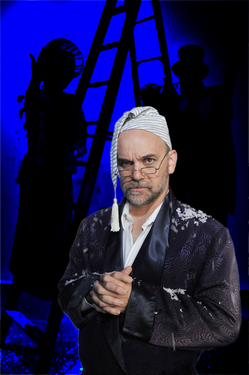Performance Network's "Christmas Carol'd" is a mixed blessing

For better or for worse, this quintessential redemption tale became a holiday ritual long ago, thus making the story a double-edged sword for theaters that consider producing an adaptation: "Carol" is a known commodity that will always attract the faithful, so you must generally stay true to Dickens' original novella; yet patrons suffering from "Carol" fatigue won't pony up unless you demonstrate that your version offers something new and different.
Joseph Zettelmaier's "Christmas Carol'd," now playing at Performance Network, strives to cover both bases by zeroing in on Dickens' text while also highlighting scenes that are often ignored, and filling in Dickens' faint allusions to Scrooge's back story.
Plus, while John Seibert portrays Scrooge, only four additional actors play 40 characters, providing Zettelmaier and director David Wolber with considerable, and ocasionally insurmountable, logistic challenges.
Nonetheless, "Carol'd"'s best, most innovative moments are hauntingly memorable. Chief among them is the shape-shifting Ghost of Christmas Past, which is played by the show's four ensemble actors (Terry Heck, Chelsea Sadler, B. J. Love, and Kevin Young) while wearing white masks. Dickens' original description of the Ghost is wildly surreal and pretty darn impossible to represent in a non-animated medium, but Wolber and Zettelmaier (and the show's talented production team) bring us closer to the author's original vision than most adaptations dare to even try.
Set designer Monika Essen and lighting designer Daniel C. Walker, meanwhile, provide the show's most chilling visual effect when Scrooge sees the face of his deceased partner, Jacob Marley, appear in the place of his door's knocker. While this is a seemingly tricky moment to portray on a stage, Essen simply calls for a small door panel that opens in back so that an actor (Young) may push his face into a fabric screen while Walker's bright, sharply focused light ramps up the moment's eeriness.
In terms of the script, Zettelmaier tries to employ Dickens' textual flashes of humor from the outset, so that the ensemble, like a derailed Greek chorus, bickers briefly about the aptness of the phrase "dead as a doornail." Subsequent jokes in this same vein are generally less successful, however; and in one case, an often-overlooked scene — involving an economically struggling couple that earns a reprieve via Scrooge's death — doesn't have the heft to earn a place in "Carol'd," thus making you realize why it's not normally included in adaptations.
Indeed, Zettelmaier's devotion to Dickens' text is a mixed blessing. While hearing distinctly Dickensian images — such as the description of the Ghost of Christmas Past and the caroling "owner of a young nose" who sings through the keyhole of Scrooge's office — is a marvelously rich experience, the pull to include so much narration sometimes has clunky results. A few times, for instance, actors break character to narrate and then return to character; and a few bits of narration are overwhelmed by set changes, physical background action, or sound effects.
In addition, the cast's size necessitates Scrooge's integration into scenes from his own past, which not only causes costume problems (Scrooge works at Fezziwig's and with Marley while wearing a bathrobe), but means the audience loses the experience of watching this damaged man view both happy and painful scenes from his past. Since Scrooge's seismic change begins in these moments, watching his reactions to them is crucial, and without that, the section loses a bit of its power.
Nonetheless, the ensemble is terrific, with Seibert working his usual magic in the lead role, making Scrooge curt, funny, and utterly human. Essen's low-key, expressionistic set, primarily consisting of large clocks and candle-lit window frames painted in the same, muted tone, feels just right for Zettelmaier's scaled-down adaptation, as do her quick-change costumes. Walker's effective lighting, meanwhile, is a key component of this ghost story —Â from making people or gravestones glow, to making a red light stand in for the Ghost of Christmas Yet to Come.
Overall, Wolber and his actors present a solid production of Zettelmaier's adaptation. And while the show has its flaws, it achieves its primary aim of bringing Dickens' imaginative voice back to a familiar holiday staple.
Jenn McKee is the entertainment digital journalist for AnnArbor.com. Reach her at jennmckee@annarbor.com or 734-623-2546, and follow her on Twitter @jennmckee.

